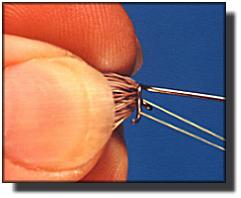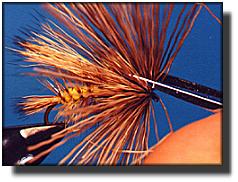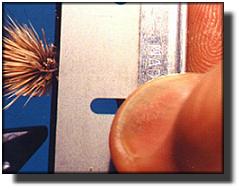
12. Whip finish behind the hook eye. I like to use the Thompson style whip
finisher here because it works so well in tight places. If you need a refresher
on the use of this whip finisher, go back to
part 6 in the archives for a view
of the procedures.

13. Begin shaping the hair head with your scissors. Start by squaring it out,
trimming the top, then the bottom, then the sides. Leave the hair a little long;
you'll create the final shape with a razor blade next. Trim only the butt ends
of the hair, leaving the tip ends to sweep back over the wing and front part
of the body.

14. When you have the head roughly shaped to the right proportions, use a
razor to refine the proportions of the head to the right size and shape. Use
a sharp razor for this task, but be careful you don't refine the shape of your
fingers during the process. Razor shaping gives you a nice, smooth head
that looks nice and tends to hold up better under stress than scissors shaping
does.

15. When you've finished refining the shape of the hair head, your fly should
look like this. Apply a liberal amount of head cement to the thread behind the
hook eye and the base of the hair head. Let the cement soak into the hair
thoroughly so the head won't loosen up with use.
I also tie this pattern in colors to match stoneflies and crickets. For
the cricket, I use a standard dry fly hook and dyed black hair. You'll find this
pattern floats great and the hair head looks more natural to the fish than a hackle
head does. Panfish addicts will enjoy the fast action Al's Cricket produces in
their local lake, and fast water addicts will enjoy the floatation of Al's Stone.
If your first flies don't look as nice as you'd like, don't throw them
away, just practice a little more. For some reason, the fish don't mind flies
that don't look perfect nearly as much as us fishermen do. Keep your first
attempts at this fly and fish them. If you're like me, you'll probably lose them
to the grass or brush anyway, and if not, the fish usually won't care. After all,
pretty flies are for fishermen, but this fly is for the fish.
Until next week my friends, practice and have fun.
See ya next week - Remember, I'm always happy to answer
your questions, feel free to
email me. ~ Al Campbell
Fly Tying Archives
|











